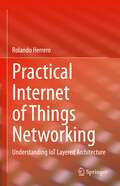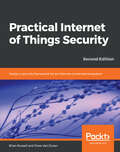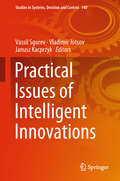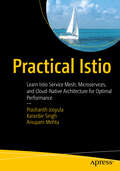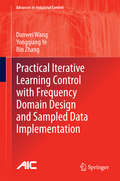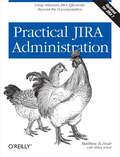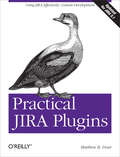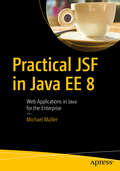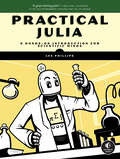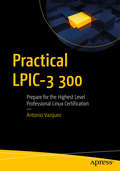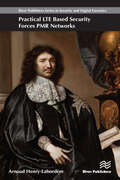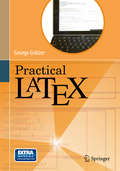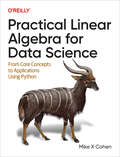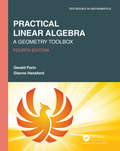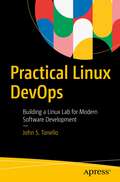- Table View
- List View
Practical Insecurity: The Layman's Guide to Digital Security and Digital Self-defense (River Publishers Series in Rapids in Security and Digital Forensics)
by Lyndon MarshallThis book provides practical advice for everyone on how to effectively secure yourself, your devices, and your privacy in an era where all of those things seem doomed. From acquiring software, to the ongoing flaws in email, to the risks of file sharing, and issues surrounding social media and social reputation, Practical Insecurity is the tool you need to maximize your self-protection in the digital world. Everyone has had a brush with cybersecurity—in some way. Our computer has gotten a virus, somebody you know has lost all their company’s data because of ransomware, someone has stolen our identity, a store we do business with has their computer system compromised—including our account—so we are offered free identity protection, and so on. It seems like everyday there is another bit of bad news and it often impacts us. But, the question largely goes unanswered: what can I do as an individual or as the owner of a small business to protect myself against having my security compromised? Practical Insecurity provides the answers.
Practical Internet Server Configuration: Learn to Build a Fully Functional and Well-Secured Enterprise Class Internet Server
by Robert La LauLearn the skills to complete the full installation, configuration, and maintenance of an enterprise class internet server, no matter what Unix-like operating system you prefer. This book will rapidly guide you towards real system administration, with clear explanations along the way.After a chapter explaining the most important Unix basics, you will start with a vanilla server as delivered by a hosting provider and by the end of the book, you will have a fully functional and well-secured enterprise class internet server. You will also be equipped with the expertise needed to keep your server secured and up to date. All configuration examples are given for FreeBSD, Debian and CentOS, so you are free to choose your operating system. No single blueprint exists for an internet server, and an important part of the work of a system administrator consists of analyzing, interpreting and implementing specific wishes, demands and restrictions from different departments and viewpoints within an organization. Practical Internet Server Configuration provides the information you need to succeed as a sysadmin. What You'll Learn Configure DNS using Bind 9Set up Apache and NginxCustomize a mail server: IMAP (Dovecot) and SMTP (Postfix), spam filtering includedAuthenticate mail users using LDAPInstall and maintain MariaDB and PostgreSQL databasesPrepare SSL/TLS certificates for the encryption of web, mail and LDAP trafficSynchronize files, calendars and address books between devicesBuild a firewall: PF for FreeBSD and nftables for Linux Who This Book Is For This book can be used by aspiring and beginning system administrators who are working on personal servers, or more experienced system administrators who may know Unix well but need a reference book for the more specialized work that falls outside the daily routine. Basic understanding of Unix and working on the command line is necessary.
Practical Internet of Things Networking: Understanding IoT Layered Architecture
by Rolando HerreroThis textbook explores the different protocols and technologies that are key to supporting the most important Internet of Things (IoT) networking scenarios. Intended for upper undergraduate classes, the author presents these protocols and technologies from a perspective of the standard layered architecture with special focus on protocol interaction and functionality. To this end, the book provides a unique step-by-step hands-on approach that enables the reader to use common software tools and network emulators to understand, prototype, and deploy a vast range of use cases. The author shows how these topologies, which rely on standard physical layer technologies like LoRa, NB-IoT, LTE-M, IEEE 802.15.4 and BLE, provide end-to-end IPv6 connectivity and comply with the most important requirements of industrial IoT solutions. The book helps readers learn how to build IoT networks through exercises, lab projects, and examples.
Practical Internet of Things Security
by Brian Russell Drew Van DurenA practical, indispensable security guide that will navigate you through the complex realm of securely building and deploying systems in our IoT-connected world About This Book * Learn to design and implement cyber security strategies for your organization * Learn to protect cyber-physical systems and utilize forensic data analysis to beat vulnerabilities in your IoT ecosystem * Learn best practices to secure your data from device to the cloud * Gain insight into privacy-enhancing techniques and technologies Who This Book Is For This book targets IT Security Professionals and Security Engineers (including pentesters, security architects and ethical hackers) who would like to ensure security of their organization's data when connected through the IoT. Business analysts and managers will also find it useful. What You Will Learn * Learn how to break down cross-industry barriers by adopting the best practices for IoT deployments * Build a rock-solid security program for IoT that is cost-effective and easy to maintain * Demystify complex topics such as cryptography, privacy, and penetration testing to improve your security posture * See how the selection of individual components can affect the security posture of the entire system * Use Systems Security Engineering and Privacy-by-design principles to design a secure IoT ecosystem * Get to know how to leverage the burdgening cloud-based systems that will support the IoT into the future. In Detail With the advent of Intenret of Things (IoT), businesses will be faced with defending against new types of threats. The business ecosystem now includes cloud computing infrastructure, mobile and fixed endpoints that open up new attack surfaces, a desire to share information with many stakeholders and a need to take action quickly based on large quantities of collected data. . It therefore becomes critical to ensure that cyber security threats are contained to a minimum when implementing new IoT services and solutions. . The interconnectivity of people, devices, and companies raises stakes to a new level as computing and action become even more mobile, everything becomes connected to the cloud, and infrastructure is strained to securely manage the billions of devices that will connect us all to the IoT. This book shows you how to implement cyber-security solutions, IoT design best practices and risk mitigation methodologies to address device and infrastructure threats to IoT solutions. This book will take readers on a journey that begins with understanding the IoT and how it can be applied in various industries, goes on to describe the security challenges associated with the IoT, and then provides a set of guidelines to architect and deploy a secure IoT in your Enterprise. The book will showcase how the IoT is implemented in early-adopting industries and describe how lessons can be learned and shared across diverse industries to support a secure IoT. Style and approach This book aims to educate readers on key areas in IoT security. It walks readers through engaging with security challenges and then provides answers on how to successfully manage IoT security and build a safe infrastructure for smart devices. After reading this book, you will understand the true potential of tools and solutions in order to build real-time security intelligence on IoT networks.
Practical Internet of Things Security: Design a security framework for an Internet connected ecosystem
by Brian Russell Drew Van DurenA practical, indispensable security guide that will navigate you through the complex realm of securely building and deploying systems in our IoT-connected world Key FeaturesLearn best practices to secure your data from the device to the cloudUse systems security engineering and privacy-by-design principles to design a secure IoT ecosystemA practical guide that will help you design and implement cyber security strategies for your organizationBook DescriptionWith the advent of the Internet of Things (IoT), businesses have to defend against new types of threat. The business ecosystem now includes the cloud computing infrastructure, mobile and fixed endpoints that open up new attack surfaces. It therefore becomes critical to ensure that cybersecurity threats are contained to a minimum when implementing new IoT services and solutions. This book shows you how to implement cybersecurity solutions, IoT design best practices, and risk mitigation methodologies to address device and infrastructure threats to IoT solutions. In this second edition, you will go through some typical and unique vulnerabilities seen within various layers of the IoT technology stack and also learn new ways in which IT and physical threats interact. You will then explore the different engineering approaches a developer/manufacturer might take to securely design and deploy IoT devices. Furthermore, you will securely develop your own custom additions for an enterprise IoT implementation. You will also be provided with actionable guidance through setting up a cryptographic infrastructure for your IoT implementations. You will then be guided on the selection and configuration of Identity and Access Management solutions for an IoT implementation. In conclusion, you will explore cloud security architectures and security best practices for operating and managing cross-organizational, multi-domain IoT deployments.What you will learnDiscuss the need for separate security requirements and apply security engineering principles on IoT devicesMaster the operational aspects of planning, deploying, managing, monitoring, and detecting the remediation and disposal of IoT systemsUse Blockchain solutions for IoT authenticity and integrityExplore additional privacy features emerging in the IoT industry, such as anonymity, tracking issues, and countermeasuresDesign a fog computing architecture to support IoT edge analyticsDetect and respond to IoT security incidents and compromisesWho this book is forThis book targets IT Security Professionals and Security Engineers (including pentesters, security architects and ethical hackers) who would like to ensure the security of their organization's data when connected through the IoT. Business analysts and managers will also find this book useful.
Practical Internet of Things with JavaScript: Build standalone exciting IoT projects with Raspberry Pi 3 and JavaScript (ES5/ES6)
by Arvind RavulavaruEnd to end solutions for IoT enthusiasts and web developers Key Features Leverage the capability of IoT with the combination of Raspberry Pi 3 and JavaScript (ES5/ES6) Develop a health monitoring device along with some cool projects like Smart Agriculture & Raspberry Pi 3 based surveillance. A practical book which will help you build Mobile/Web/Desktop apps that will show how to manage and monitor data from sensors and actuators in real time. Book Description In this world of technology upgrades, IoT is currently leading with its promise to make the world a more smarter and efficient place. This book will show you how to build simple IoT solutions that will help you to understand how this technology works. We would not only explore the IoT solution stack, but we will also see how to do it with the world’s most misunderstood programming language - JavaScript. Using Raspberry Pi 3 and JavaScript (ES5/ES6) as the base to build all the projects, you will begin with learning about the fundamentals of IoT and then build a standard framework for developing all the applications covered in this book. You will then move on to build a weather station with temperature, humidity and moisture sensors and further integrate Alexa with it. Further, you will build a smart wearable for understanding the concept of fall detection. You will then extend it with the 'If This Then That' (IFTTT) rules engine to send an email on fall detection. Finally, you will be working with the Raspberry Pi 3 camera module and surveillance with a bit of facial detection using Amazon Rekognition platform. At the end of the book, you will not only be able to build standalone exciting IoT applications but also learn how you can extend your projects to another level. What you will learn Integrate sensors and actuators with the cloud and control them for your Smart Weather Station. Develop your very own Amazon Alexa integrating with your IoT solution Define custom rules and execute jobs on certain data events using IFTTT Build a simple surveillance solutions using Amazon Recognition & Raspberry Pi 3 Design a fall detection system and build a notification system for it. Use Amazon Rekognition for face detection and face recognition in your Surveillance project Who this book is for This book targets IoT enthusiasts and web developers who would like to build IoT-based applications with Raspberry Pi, Arduino and JavaScript. Some knowledge about electronics and familiarity with programming concepts (JavaScript - ES5/ES6) is expected.
Practical IoT Hacking: The Definitive Guide to Attacking the Internet of Things
by Fotios Chantzis Ioannis Stais Paulino Calderon Evangelos Deirmentzoglou Beau WoodsThe definitive guide to hacking the world of the Internet of Things (IoT) -- Internet connected devices such as medical devices, home assistants, smart home appliances and more.Drawing from the real-life exploits of five highly regarded IoT security researchers, Practical IoT Hacking teaches you how to test IoT systems, devices, and protocols to mitigate risk. The book begins by walking you through common threats and a threat modeling framework. You&’ll develop a security testing methodology, discover the art of passive reconnaissance, and assess security on all layers of an IoT system. Next, you&’ll perform VLAN hopping, crack MQTT authentication, abuse UPnP, develop an mDNS poisoner, and craft WS-Discovery attacks. You&’ll tackle both hardware hacking and radio hacking, with in-depth coverage of attacks against embedded IoT devices and RFID systems. You&’ll also learn how to: • Write a DICOM service scanner as an NSE module • Hack a microcontroller through the UART and SWD interfaces • Reverse engineer firmware and analyze mobile companion apps • Develop an NFC fuzzer using Proxmark3 • Hack a smart home by jamming wireless alarms, playing back IP camera feeds, and controlling a smart treadmill The tools and devices you&’ll use are affordable and readily available, so you can easily practice what you learn. Whether you&’re a security researcher, IT team member, or hacking hobbyist, you&’ll find Practical IoT Hacking indispensable in your efforts to hack all the things REQUIREMENTS: Basic knowledge of Linux command line, TCP/IP, and programming
Practical Issues of Intelligent Innovations (Studies in Systems, Decision and Control #140)
by Janusz Kacprzyk Vassil Sgurev Vladimir JotsovThis book presents recent advances in the field of intelligent systems. Composed of fourteen selected chapters, it covers a wide range of research that varies from applications in industrial data science to those in applied science. Today the word INNOVATION is more and more connected with the words INTELLIGENT and SECURITY, as such the book discusses the theory and applications of hot topics such as big data, education applications of robots with different levels of autonomy, knowledge-based modeling and control of complex dynamical systems, sign-based synthesis of behavior, security issues with intelligent systems, innovative intelligent control design, neuromorphic computation, data-driven classification, intelligent modeling and measurement innovations, multisensor data association, personal education assistants, a modern production architecture, study of peer review and scientometrics, intelligent research on bug report data, and clustering non-Gaussian data. The broad and varied research discussed represents the mainstream of contemporary intelligent innovations that are slowly but surely changing the world.
Practical Istio: Learn Istio Service Mesh, Microservices, and Cloud-Native Architecture for Optimal Performance
by Prashanth Josyula Karanbir Singh Anupam MehtaIstio is a powerful service mesh technology that enhances the security, observability, and traffic management of microservices within cloud-native architectures. As organizations increasingly adopt microservices, managing the complexity of service interactions becomes critical. This book is designed to help professionals navigate these complexities by providing a deep understanding of Istio, empowering them to leverage their full potential in building resilient, scalable, and secure service infrastructures. Practical Istio offers a comprehensive journey through the service mesh, beginning with an introduction to its architecture and fundamental concepts. Readers will delve into advanced topics such as traffic management, security enforcement, and observability, gaining insights into how to implement and optimize Istio in real-world scenarios. Each chapter is crafted to provide practical guidance, including detailed explanations of Istio&’s key components, like 'Istiod' and 'Envoy', hands-on examples for managing production grade deployments, and strategies for integrating Istio with CI/CD pipelines. The book also covers emerging trends and future directions of service mesh technology, ensuring readers stay ahead of the curve. By the end of this book, readers will be equipped with the knowledge and skills needed to implement Istio in production environments. Whether you&’re a DevOps engineer, a cloud architect, or a software developer, this book will elevate your understanding of service mesh technology, enabling you to build robust, secure, and efficient microservices architectures with Istio at the core. You Will Learn: ● Istio&’s architecture and core components enable you to effectively manage and secure microservices in a cloud-native environment. ● Practical skills in traffic management, security, and observability to optimize service performance and reliability <p class="MsoNormal" style="text-indent: -18.0pt; line-height: normal; mso-list:
Practical Iterative Learning Control with Frequency Domain Design and Sampled Data Implementation
by Danwei Wang Yongqiang Ye Bin ZhangThis book is on the iterative learning control (ILC) with focus on the design and implementation. We approach the ILC design based on the frequency domain analysis and address the ILC implementation based on the sampled data methods. This is the first book of ILC from frequency domain and sampled data methodologies. The frequency domain design methods offer ILC users insights to the convergence performance which is of practical benefits. This book presents a comprehensive framework with various methodologies to ensure the learnable bandwidth in the ILC system to be set with a balance between learning performance and learning stability. The sampled data implementation ensures effective execution of ILC in practical dynamic systems. The presented sampled data ILC methods also ensure the balance of performance and stability of learning process. Furthermore, the presented theories and methodologies are tested with an ILC controlled robotic system. The experimental results show that the machines can work in much higher accuracy than a feedback control alone can offer. With the proposed ILC algorithms, it is possible that machines can work to their hardware design limits set by sensors and actuators. The target audience for this book includes scientists, engineers and practitioners involved in any systems with repetitive operations.
Practical JAMstack: Blazing Fast, Simple, and Secure Web Development, the Modern Way
by Frank ZammettiLearn what JAMstack is all about, what those three big letters in the front mean and why it’s so beneficial. This book shows you how to create sites and apps on the JAMstack using GatsbyJS, a tool made specifically for generating them. As part of that, you’ll learn about React, one of the hottest front-end development tools out there today. You will build three separate projects, starting with a relatively simple site to get your feet wet, then a more robust and dynamic application to see more advanced topics like API usage and data storage. Finally, you’ll build a game on the JAMstack to get a whole different perspective on how all the pieces can fit together. JAMstack, a modern take on best practices, is taking the web development world by storm and allowing developers to create web site and apps that are blazingly fast and highly secure. In many ways JAMstack is a throwback to web development of yesteryear, all while providing a simpler development experience that is streamlined by many years of best practices being brought to bear. What You'll Learn Review the principles of JAMstack: Javascript, APIs and MarkupUse React to build a front-endSet up a GitHub account and hosting using GitHub PagesHost in Netlify (the creators of JAMstack!)Understand Netlify functions and FaunaDB for persistent data storageExplore GraphQL usage for querying dataWork with the Phaser game library Who This Book Is ForWeb developers with some HTML, CSS and JavaScript experience, who want to apply best practices to build web sites that have no back-end server infrastructure while still providing dynamic content along with a streamlined development process. Architects who just want to learn JAMstack, even if they aren’t going to be hacking code all day.
Practical JIRA Administration: Using JIRA Effectively: Beyond the Documentation
by Matthew B. DoarIf you're familiar with JIRA for issue tracking, bug tracking, and other uses, you know it can sometimes be tricky to set up and manage. In this concise book, software toolsmith Matt Doar clarifies some of the more confusing aspects by answering difficult and frequently asked questions about JIRA administration.Practical JIRA Administration shows you how JIRA is intended to be used, making it an ideal supplement to the extensive documentation already available. The book’s chapters are loosely connected, so you can go straight to the information that best serves your needs.Understand the difference between JIRA groups and JIRA project rolesDiscover what JIRA schemes do, and learn how to maintain themUse a consistent configuration approach to help you use JIRA as a platformCreate a workflow from scratchAdd, modify, and deactivate usersPrepare for a JIRA upgrade, and troubleshoot if necessaryGet remote access to JIRA via email, SQL, REST, and other methods
Practical JIRA Plugins: Using JIRA Effectively: Custom Development
by Matthew B. DoarOne advantage of using JIRA for issue tracking, bug tracking, or project management is the ability to extend this tool with hundreds of plugins from the JIRA community. In this concise book, software toolsmith Matt Doar—the author of Practical JIRA Administration—shows you how to create and maintain your own JIRA plugins to meet the specific needs of a project.This book uses detailed examples to clarify some of the more confusing aspects of JIRA plugins, and serves as an ideal supplement to the extensive documentation already available.Use JIRA’s Plugin SDK, and learn several aspects common to all pluginsCreate your own custom field type, using a JIRA pluginDelve into advanced aspects of custom field plugins, and discover how searching for values in custom fields worksCreate JIRA plugins to use with workflows, and learn about conditions, validators, and post-functionsStore data using the PropertySet interface and the Active Objects pluginUpgrade a plugin and upload it to Atlassian Plugin Exchange (PAC)
Practical JSF in Java EE 8: Web Applications in Java for the Enterprise
by Michael MüllerMaster the Java EE 8 and JSF (JavaServer Faces) APIs and web framework with this practical, projects-driven guide to web development. This book combines theoretical background with a practical approach by building four real-world applications. By developing these JSF web applications, you'll take a tour through the other Java EE technologies such as JPA, CDI, Security, WebSockets, and more.In Practical JSF in Java EE 8, you will learn to use the JavaServer Faces web framework in Java EE 8 to easily construct a web-based user interface from a set of reusable components. Next, you add JSF event handling and then link to a database, persist data, and add security and the other bells and whistles that the Java EE 8 platform has to offer.After reading this book you will have a good foundation in Java-based web development and will have increased your proficiency in sophisticated Java EE 8 web development using the JSF framework.What You Will Learn Use the Java EE 8 and the JavaServer Faces APIs to build Java-based web applications through four practical real-world case studies Process user input with JSF and the expression language by building a calculator application Persist data using JSF templating and Java Persistence to manage an inventory of books Create and manage an alumni database using JSF, Ajax, web services and Java EE 8's security features. Who This Book Is For Those new to Java EE 8 and JSF. Some prior experience with Java is recommended.
Practical Java Machine Learning: Projects with Google Cloud Platform and Amazon Web Services
by Mark WickhamBuild machine learning (ML) solutions for Java development. This book shows you that when designing ML apps, data is the key driver and must be considered throughout all phases of the project life cycle. Practical Java Machine Learning helps you understand the importance of data and how to organize it for use within your ML project. You will be introduced to tools which can help you identify and manage your data including JSON, visualization, NoSQL databases, and cloud platforms including Google Cloud Platform and Amazon Web Services.Practical Java Machine Learning includes multiple projects, with particular focus on the Android mobile platform and features such as sensors, camera, and connectivity, each of which produce data that can power unique machine learning solutions. You will learn to build a variety of applications that demonstrate the capabilities of the Google Cloud Platform machine learning API, including data visualization for Java; document classification using the Weka ML environment; audio file classification for Android using ML with spectrogram voice data; and machine learning using device sensor data.After reading this book, you will come away with case study examples and projects that you can take away as templates for re-use and exploration for your own machine learning programming projects with Java.What You Will LearnIdentify, organize, and architect the data required for ML projectsDeploy ML solutions in conjunction with cloud providers such as Google and AmazonDetermine which algorithm is the most appropriate for a specific ML problemImplement Java ML solutions on Android mobile devicesCreate Java ML solutions to work with sensor dataBuild Java streaming based solutionsWho This Book Is ForExperienced Java developers who have not implemented machine learning techniques before.
Practical Java Programming for IoT, AI, and Blockchain
by Perry XiaoLearn practical uses for some of the hottest tech applications trending among technology professionals We are living in an era of digital revolution. On the horizon, many emerging digital technologies are being developed at a breathtaking speed. Whether we like it or not, whether we are ready or not, digital technologies are going to penetrate more and more, deeper and deeper, into every aspect of our lives. This is going to fundamentally change how we live, how we work, and how we socialize. Java, as a modern high-level programming language, is an excellent tool for helping us to learn these digital technologies, as well as to develop digital applications, such as IoT, AI, Cybersecurity, Blockchain and more. Practical Java Programming uses Java as a tool to help you learn these new digital technologies and to be better prepared for the future changes. Gives you a brief overview for getting started with Java Programming Dives into how you can apply your new knowledge to some of the biggest trending applications today Helps you understand how to program Java to interact with operating systems, networking, and mobile applications Shows you how Java can be used in trending tech applications such as IoT (Internet of Things), AI (Artificial Intelligence), Cybersecurity, and Blockchain Get ready to find out firsthand how Java can be used for connected home devices, healthcare, the cloud, and all the hottest tech applications.
Practical Julia: A Hands-On Introduction for Scientific Minds
by Lee PhillipsLearn to use Julia as a tool for research, and solve problems of genuine interest—like modeling the course of a pandemic—in this practical, hands-on introduction to the language.The Julia programming language is acclaimed in scientific circles for its unparalleled ease, interactivity, and speed. Practical Julia is a comprehensive introduction to the language, making it accessible even if you&’re new to programming.Dive in with a thorough guide to Julia&’s syntax, data types, and best practices, then transition to craft solutions for challenges in physics, statistics, biology, mathematics, scientific machine learning, and more. Whether you&’re solving computational problems, visualizing data, writing simulations, or developing specialized tools, Practical Julia will show you how.As you work through the book, you&’ll:• Use comprehensions and generators, higher-level functions, array initialization and manipulation, and perform operations on Unicode text• Create new syntax and generate code with metaprogramming and macros, and control the error system to manipulate program execution• Visualize everything from mathematical constructs and experimental designs to algorithm flowcharts• Elevate performance using Julia&’s unique type system with multiple dispatch• Delve into scientific packages tailored for diverse fields like fluid dynamics, agent-based modeling, and image processingWhether your interest is in scientific research, statistics, mathematics, or just the fun of programming with Julia, Practical Julia will have you writing high-performance code that can do real work in no time.Online Resources: Ready-to-run code samples, illustrations, and supplemental animations available at https://julia.lee-phillips.org.
Practical LPIC-1 Linux Certification Study Guide
by David ClintonThis book is your complete guide to studying for the Linux Professional Institute's Server Professional (LPIC-1) certification. Every concept, principle, process, and resource that might make an appearance on the exam is fully represented. You will understand every concept by rolling up your sleeves, opening up a terminal, and trying it all yourself. You will find suggestions for practical tasks along with "test-yourself" quizzes at the end of each chapter. Whether you've decided to earn the Linux Professional Institute's Server Professional certification or you simply want to learn more about Linux administration, this book is a great choice. Right now, Linux administration skills are opening doors to some of the hottest job markets. And with the ongoing explosive growth of the cloud computing world - the vast majority of which is being built with Linux - the scope of the opportunities will only increase. Whether or not you end up taking the exam, if you manage to learn this material, you'll have done yourself a real favor. What You Will Learn Basic Linux system administration and package management Device and desktop management Bash scripting Networking fundamentals Security administration Who This Book Is For Most potential readers will already have a decent idea of what Linux is and what kinds of things can be done with it, and are looking to acquire or formalize a more structured and complete ability to confidently administrate Linux systems.
Practical LPIC-3 300: Prepare for the Highest Level Professional Linux Certification
by Antonio VazquezGain the essential skills and hands-on expertise required to pass the LPIC-3 300 certification exam. This book provides the insight for you to confidently install, manage and troubleshoot OpenLDAP, Samba, and FreeIPA. Helping you to get started from scratch, this guide is divided into three comprehensive sections covering everything you'll need to prepare for the exam.Part 1 focuses on OpenLDAP and topics including securing the directory, integration with PAM and replication. Part 2 covers Samba and teaches you about Samba architecture, using different back ends, print services, and deploying Samba as a stand-alone server, PDC, and Active Directory Domain Controller. Finally, Part 3 explains how to manage FreeIPA and how to integrate it with Active Directory.Practical LPIC-3 300 is the perfect study guide for anyone interested in the LPIC-3 300 certification exam, OpenLDAP, Samba, or FreeIPA.What You'll Learn Integrate LDAP with PAM and NSS, and with Active Directory and KerberosManage OpenLDAP replication and server performance tuningUse Samba as a PDC and BDCConfigure Samba as a domain member server in an existing NT domainUse Samba as an AD Compatible Domain ControllerReplicate, manage, and integrate FreeIPA Who This Book Is For This book is for anyone who is preparing for the LPIC-3 300 exam, or those interested in learning about OpenLDAP and Samba in general.
Practical LTE based security forces PMR networks
by Arnaud Henry-LabordèreSecurity forces PMR networks are moving from proprietary technologies for their Mission Critical Push-To-Talk basic service, and their data services which must provide large bandwidth real-time access, to the databases. LTE Based is adopted with backup access to public MNOs to complement their own radio coverage. Specific technologies such as multicasting of visio are required so the MCPTT works within a restricted bandwidth. The need to be able to change the main MNOs to provide resilient coverage requires specific choices of SIM cards, with OTAble security domains. Practical LTE Based Security Forces PMR Networks assumes that the reader has a basic knowledge of the 4G network architecture and services, and the book focusses on the specific features and choices required to fulfill the need of security forces PMR networks. These include tactical and centralized, including LTE based voice services VoLTE and IMS. It can be used as a reference or textbook, with many detailed call flows and traces being included. The author, who has also a long teaching career in Operations Research, provides mathematical models for the optimization of tactical network federations, multicast coverage and allocation of preemptive priorities to PMR group members. He is a pioneer in the area of Virtual Roaming, an application of graph theory and telecommunications to provide roaming without direct relations, having previously published books on SMS Hubs, SS7 Hubs, Diameter Hubs, GTP Hubs. The use of M2M (monitoring devices) for security forces with mobility is covered in detail in the book, including the new LoRa virtual roaming which goes beyond the scope of PMR.
Practical LaTeX
by George GrätzerPractical LaTeX covers the material that is needed for everyday LaTeX documents. This accessible manual is friendly, easy to read, and is designed to be as portable as LaTeX itself. A short chapter, Mission Impossible, introduces LaTeX documents and presentations. Read these 30 pages; you then should be able to compose your own work in LaTeX The remainder of the book delves deeper into the topics outlined in Mission Impossible while avoiding technical subjects. Chapters on presentations and illustrations are a highlight, as is the introduction of LaTeX on an iPad. Students, faculty, and professionals in the worlds of mathematics and technology will benefit greatly from this new, practical introduction to LaTeX. George Grätzer, author of More Math into LaTeX (now in its 4th edition) and First Steps in LaTeX, has been a LaTeX guru for over a quarter of century. From the reviews of More Math into LaTeX: ``There are several LaTeX guides, but this one wins hands down for the elegance of its approach and breadth of coverage. '' --Amazon. com, Best of 2000, Editors Choice ``A very helpful and useful tool for all scientists and engineers. '' --Review of Astronomical Tools``A novice reader will be able to learn the most essential features of LaTeX sufficient to begin typesetting papers within a few hours of time. . . An experienced TeX user, on the other hand, will find a systematic and detailed discussion of all LaTeX features, supporting software, and many other advanced technical issues. '' --Reports on Mathematical Physics
Practical Lakehouse Architecture: Designing and Implementing Modern Data Platforms at Scale
by Gaurav Ashok ThalpatiThis concise yet comprehensive guide explains how to adopt a data lakehouse architecture to implement modern data platforms. It reviews the design considerations, challenges, and best practices for implementing a lakehouse and provides key insights into the ways that using a lakehouse can impact your data platform, from managing structured and unstructured data and supporting BI and AI/ML use cases to enabling more rigorous data governance and security measures.Practical Lakehouse Architecture shows you how to:Understand key lakehouse concepts and features like transaction support, time travel, and schema evolutionUnderstand the differences between traditional and lakehouse data architecturesDifferentiate between various file formats and table formatsDesign lakehouse architecture layers for storage, compute, metadata management, and data consumptionImplement data governance and data security within the platformEvaluate technologies and decide on the best technology stack to implement the lakehouse for your use caseMake critical design decisions and address practical challenges to build a future-ready data platformStart your lakehouse implementation journey and migrate data from existing systems to the lakehouse
Practical Linear Algebra for Data Science: From Core Concepts to Applications Using Python
by Mike X CohenIf you want to work in any computational or technical field, you need to understand linear algebra. As the study of matrices and operations acting upon them, linear algebra is the mathematical basis of nearly all algorithms and analyses implemented in computers. But the way it's presented in decades-old textbooks is much different from how professionals use linear algebra today to solve real-world modern applications.This practical guide from Mike X Cohen teaches the core concepts of linear algebra as implemented in Python, including how they're used in data science, machine learning, deep learning, computational simulations, and biomedical data processing applications. Armed with knowledge from this book, you'll be able to understand, implement, and adapt myriad modern analysis methods and algorithms.Ideal for practitioners and students using computer technology and algorithms, this book introduces you to:The interpretations and applications of vectors and matricesMatrix arithmetic (various multiplications and transformations)Independence, rank, and inversesImportant decompositions used in applied linear algebra (including LU and QR)Eigendecomposition and singular value decompositionApplications including least-squares model fitting and principal components analysis
Practical Linear Algebra: A Geometry Toolbox (Textbooks in Mathematics)
by Gerald Farin Dianne HansfordLinear algebra is growing in importance. 3D entertainment, animations in movies and video games are developed using linear algebra. Animated characters are generated using equations straight out of this book. Linear algebra is used to extract knowledge from the massive amounts of data generated from modern technology. The Fourth Edition of this popular text introduces linear algebra in a comprehensive, geometric, and algorithmic way. The authors start with the fundamentals in 2D and 3D, then move on to higher dimensions, expanding on the fundamentals and introducing new topics, which are necessary for many real-life applications and the development of abstract thought. Applications are introduced to motivate topics. The subtitle, A Geometry Toolbox, hints at the book’s geometric approach, which is supported by many sketches and figures. Furthermore, the book covers applications of triangles, polygons, conics, and curves. Examples demonstrate each topic in action. This practical approach to a linear algebra course, whether through classroom instruction or self-study, is unique to this book. New to the Fourth Edition: Ten new application sections. A new section on change of basis. This concept now appears in several places. Chapters 14-16 on higher dimensions are notably revised. A deeper look at polynomials in the gallery of spaces. Introduces the QR decomposition and its relevance to least squares. Similarity and diagonalization are given more attention, as are eigenfunctions. A longer thread on least squares, running from orthogonal projections to a solution via SVD and the pseudoinverse. More applications for PCA have been added. More examples, exercises, and more on the kernel and general linear spaces. A list of applications has been added in Appendix A. The book gives instructors the option of tailoring the course for the primary interests of their students: mathematics, engineering, science, computer graphics, and geometric modeling.
Practical Linux DevOps: Building a Linux Lab for Modern Software Development
by John S. TonelloLearn, develop and hone your Linux and DevOps skills by building a lab for learning, testing and exploring the latest Linux and open-source technologies. This book helps Linux users and others to master modern DevOps practices using a wide range of software and tools.Having a home or work-based Linux lab is indispensable to anyone looking to experiment with the ever-evolving landscape of new software and DevOps. With open-source tools and readily available hardware, you will end up with a lab you can use to try virtually any modern software, including Chef, Docker, Kubernetes and stalwarts like DNS, Dovecot, and Postfix for email. You'll set up pipelines for software deployment and focus on discrete projects that help you learn through doing. In the end, you'll acquire the skills needed to become better informed, more marketable engineers and developers, and better able to take on a wide array of software projects with confidence.Practical Linux DevOps is the perfect companion for those who want to learn how to build systems with utility and learn about modern hardware and software practices.What You'll LearnSet up a Linux-based virtualization environment and workstationCreate a lab network with a fully qualified domainBuild web-based applications with NGINX and LAMPUse version-control tools like GitAutomate deployments and configurationsThink like a modern DevOps engineerWho This Book Is ForNew and modestly experienced users with basic understanding of a basic understanding of Windows or Linux command line, as well as would-be and current DevOps engineers, and full-stack and other software developers


